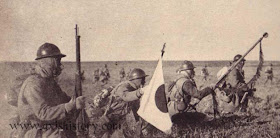Senninbari y Hinomaru
Los soldados japoneses tenían por costumbre llevarse algunos recuerdos al frente, desde su hogar, para que les trajese buena suerte. Uno de ellos era el Senninbari (una especie de cinturón) y otro muy conocido fueron las Hinomaru, banderas autografiadas. Estas recibieron el nombre de Hinomaru yosegaki;
“Cuando los nuevos reclutas y reservistas fueron llamados al servicio activo, casi invariablemente, tanto los miembros de su familia o empresa compraban una bandera de Japón y los familiares o amigos y compañeros de trabajo firmaban con su nombre escribiendo mensajes de buena suerte o mensajes patrióticos a la bandera. Durante la guerra el soldado la llevaba, cerca del cuerpo”
Senninbari
La bandera se llevaba en el bolsillo de la guerrera y también era usada para indicar su posición. Estas banderas no tenían unas medidas estándares y oscilaban en su tamaño. No es raro que las bandera originales se encuentren con arrugas de dobleces al llevarlas mucho tiempo de este modo en el bolsillo.
Fuentes:
BORTNER, M.A. “Imperial Japanese Good Luck Flags and One-thousand Stitch Belts” Schiffer Publishing Ltd, 2008
BORTNER, M.A. “Imperial Japanese Good Luck Flags and One-thousand Stitch Belts” Schiffer Publishing Ltd, 2008
HEWITT, M. “Uniforms and Equipment of the Imperial Japanese Army in World War II” Schiffer Publishing Ltd, 2004
Bandera de la suerte en Okinawa. Japanese War Museum, Naha, Okinawa, 1982
English version
The Japanese soldiers were accustomed to take some memories to the front, from home, to bring them good luck. One of them was the Senninbari (a kind of belt) and other well-known were the Hinomaru, autographed flags. These were called Hinomaru yosegaki;
”When new recruits and reservists were called to active duty, almost invariably, both members of his family company bought a Japanese flag and the relatives or friends and colleagues to sign his name writing messages of good luck or patriotic messages the flag. During the war the soldier had been close to the body”
”When new recruits and reservists were called to active duty, almost invariably, both members of his family company bought a Japanese flag and the relatives or friends and colleagues to sign his name writing messages of good luck or patriotic messages the flag. During the war the soldier had been close to the body”
The flag was carried in the pocket of his jacket and was also used to indicate its position. These flags were not standard measures and ranged in size. It is not uncommon for the original flag with wrinkles are folds to carry so much time in the pocket.
Bibliography
BORTNER, M.A. “Imperial Japanese Good Luck Flags and One-thousand Stitch Belts” Schiffer Publishing Ltd, 2008
HEWITT, M. “Uniforms and Equipment of the Imperial Japanese Army in World War II” Schiffer Publishing Ltd, 2004





No hay comentarios:
Publicar un comentario